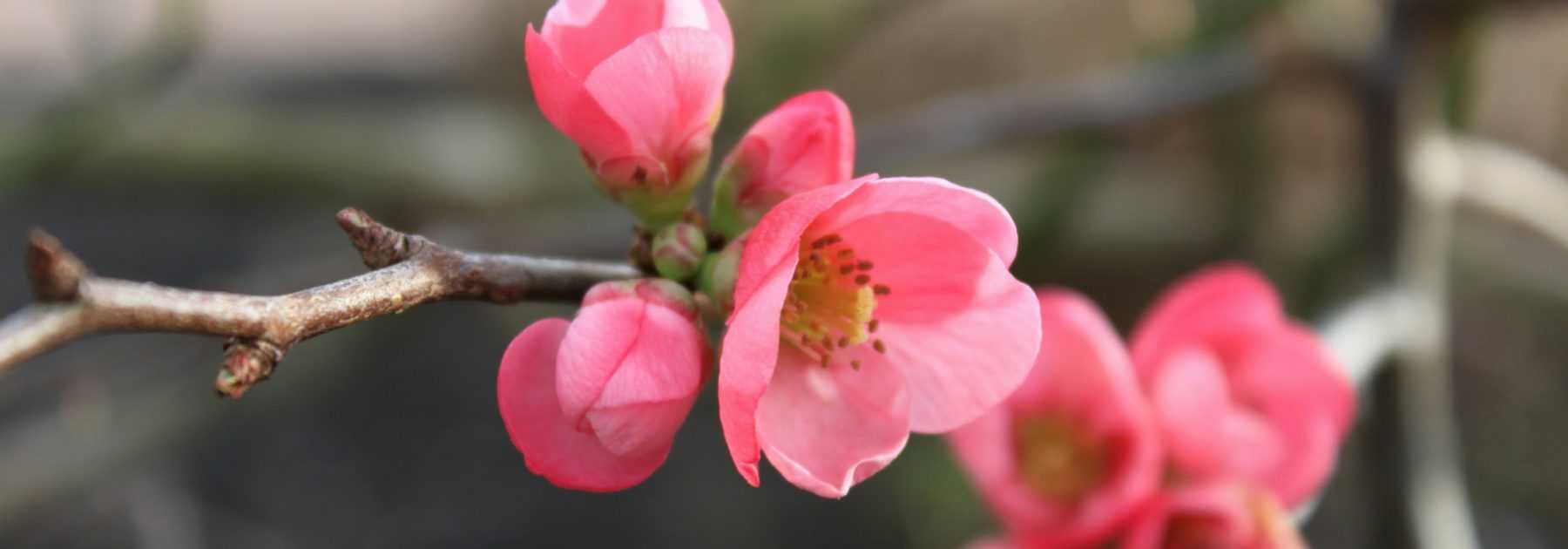
Japanese Quince: Planting, Pruning and Care
Contents
Japanese Quinces in a Nutshell
- They are highly prized for their early flowering at the end of winter and their decorative autumn fruits
- Their pink, red or white flowers appear on bare branches, before the foliage
- These are vigorous deciduous shrubs, fully hardy (-20°C)
- Easy to grow, they thrive in all soil types and become drought-resistant once established
- Their compact shape works equally well in borders, defensive hedges or even containers
Our expert's word
Often mistaken for Japanese flowering quinces, Japanese Quinces or Chaenomeles are stunning shrubs prized for their exceptionally early blooms, appearing in late winter on bare branches. Their delicate yet vibrant flowers – in pink, coral, scarlet red, or orange hues (some varieties even boast pure white blossoms, occasionally tinged with green) – bring life to gardens still dormant from the cold, creating extraordinary displays.
This floral abundance gives way in autumn to small, apple-like fruits or miniature quinces, highly fragrant when ripe and perfect for making delicious jams.
These thorny shrubs are remarkably hardy and resilient, thriving with minimal care in full sun or partial shade. They adapt to most well-drained soils, preferring fresh ground without waterlogging.
Versatile in use, they work equally well in mixed borders, as standalone specimens, or in defensive hedges where their spiny branches prove formidable. They’re equally at home in orchards, trained against walls, or even pot-grown as bonsai for a Japanese aesthetic.
Compact and pollution-tolerant, they make excellent urban garden shrubs, adding cheerful colour and striking form to city spaces.
These early-spring flowering shrubs, beloved for their prolific blooms and unusual shapes, suit all natural gardens – equally at home in romantic English gardens or contemporary designs. Their twisted branches offer striking Ikebana-style decorative potential in minimalist arrangements.
From Chaenomeles japonica to Chaenomeles speciosa and Chaenomeles x superba, discover our complete guide to growing, caring for, and maintaining Japanese quinces.
Botany
Botanical data
- Latin name Chaenomeles
- Family Rosaceae
- Common name Japanese Quince, Flowering Quince
- Flowering From February to June
- Height 1 to 5 m
- Exposure Sun, partial shade
- Soil type All types, well-drained
- Hardiness -20° to -25°C
Belonging to the Rosaceae family, Japanese Quinces or Chaenomeles, are deciduous shrubs, most often thorny. In the wild, these vigorous shrubs grow in mountain forests and along lake shores in East Asia, China and Japan. Perfectly hardy, they adapt well to various environments.
The Chaenomeles genus includes four species: C. japonica, the type species native to Japan, and three Chinese species, C. cathayensis, C. speciosa and C. thibetica. There are few species, but many cultivars have been developed. Chaenomeles x superba is an excellent hybrid of Chaenomeles japonica and Chaenomeles speciosa, with numerous varieties available.
There are two categories of Chaenomeles: the C. superba, which produce smaller but more abundant flowers, with a more compact habit and slightly more twisted branching than the C. speciosa. The latter are recognised by their large flowers. They flower slightly later than the C. superba and are also somewhat taller.
All these species and their various hybrids are commonly called “Japanese Quince”, despite their different origins. They are also known as “Flowering Quince” in contrast to the fruiting quince (Cydonia oblonga), and are sometimes confused with “Japanese Crab Apples”, which belong to the Malus genus.
Their more or less spreading silhouette varies depending on the species and offers a great diversity in size, ranging from small 1 m bushes, valuable as ground cover, to shrubs like C. cathayensis, which can reach 3 m in height and almost as much in width. While most form a dense, compact, rounded and upright bush, Chaenomeles japonica stands out for its more prostrate growth.
With fairly rapid growth, these shrubs reach two-thirds of their mature height in five years and become denser over the years.
Chaenomeles form shrubs with a rather unruly, bushy habit, with branches covered in fine, tangled thorns mixed with more rigid, vigorous shoots. Some cultivars, such as Chaenomeles speciosa ‘Mango Storm’ or Chaenomeles speciosa ‘Scarlet Storm’, are thornless.
Japanese Quinces begin flowering as early as February in some regions. They become covered in a multitude of cup-shaped flower clusters, remarkable because they appear before the leaves, on still bare branches, when the garden is still dormant and often bare.
From late winter until June, these bright little corolles adorn the bare wood until the young foliage appears, blooming in dozens, grouped in twos or fives on the thorny branches from the previous year.
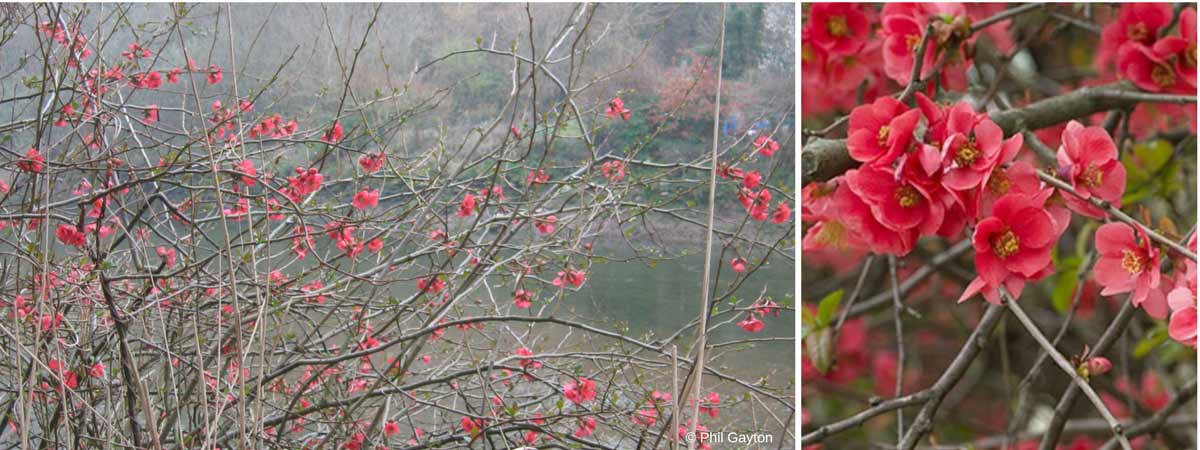
They literally transform these somewhat stiff shrubs, giving them a spectacular dimension. The flower buds, resembling small sugar candies, will look magnificent when covered in late frost.
This flowering lasts about 3 to 4 weeks.
Delicate and somewhat waxy, these corolles come in an infinite variety of colours, ranging from the brightest red to pure white, through all shades of pink and salmon, from rosy white, pale pink to purplish pink, with darker undersides. Some are lightly scented.
The Chaenomeles speciosa Eximia is covered in a multitude of carmine-pink flowers, while ‘Hot Fire’ stands out from other quinces with its fiery red blooms, and the ‘Kinshiden’ bears green flowers tinged with creamy white, of rare elegance.
Coral orange, soft salmon pink, bright pink or white depending on the species, the flowers have a single, semi-double or double corolla, 3 to 6 cm in diameter for the largest (Chaenomeles speciosa ‘Mango Storm’), sometimes composed of numerous petals, occasionally delicately ruffled and overlapping in some varieties, resembling certain roses or camellias more than quince blossoms. Often barely open, they reveal a heart of yellow stamens.
These thorny, bare branches studded with flowers are very graphic in bouquets and valuable in Japanese ikebana arrangements. They make excellent bonsai, highly prized by the Japanese for their airy and abundant flowering.
In autumn, this flowering gives way to small decorative and very fragrant fruits, provided several plants are grown together, resembling small apples or quinces, yellow, green, sometimes tinged with purple, which persist on the shrub long after the leaves have fallen. Some sterile hybrids do not produce fruit. With a slightly tart flavour, they are edible when cooked into jellies or jams, and are also used in liqueurs. However, they are less tasty than traditional quinces from fruiting quince trees (Cydonia oblonga). They are mainly of olfactory interest. Their scent is so close to ylang-ylang that a perfume was once extracted from them: “Cananga essence”.
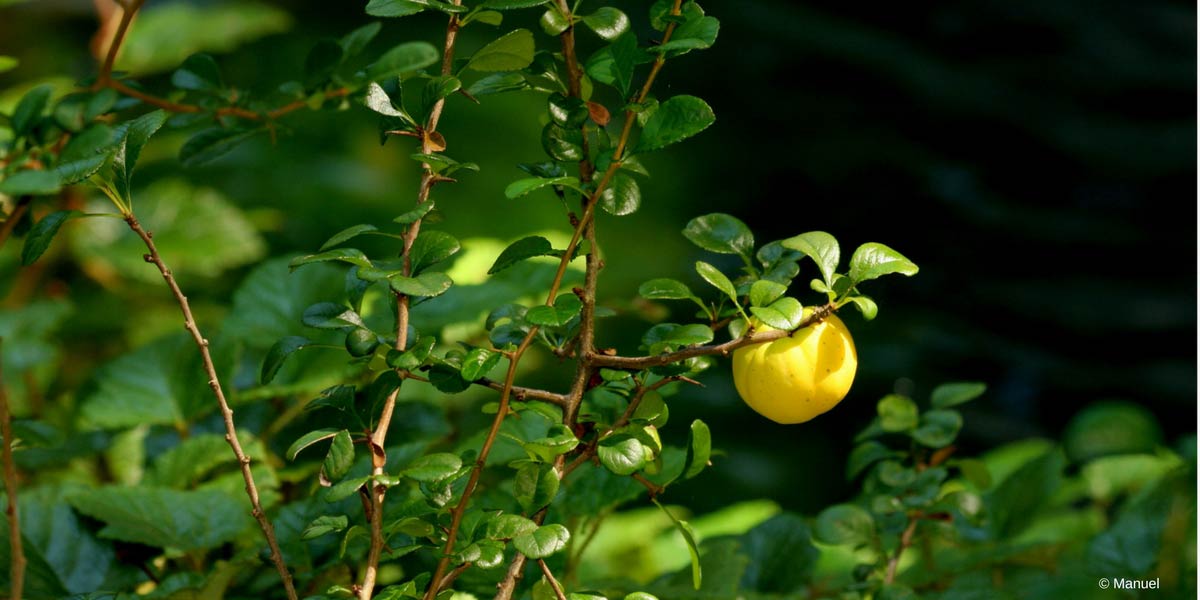
The fruit of the Japanese Quince and its thorny branches
In autumn, the foliage is another asset of Japanese Quinces. It emerges on the bare brown branches at the same time as or shortly after flowering. Medium to dark glossy green in spring, the narrow, lanceolate, veined leaves, 2 to 12 cm long, take on golden yellow hues in autumn, sometimes washed with carmine, before falling at the first frosts.
Japanese Quinces are perfectly hardy shrubs, tolerating temperatures down to -25°C, and adapt to all regions as they fear neither heat nor cold.
To flower well, they require a position in non-scorching sun, though they also adapt to partial shade. They can be planted in any ordinary, not too chalky soil, well-drained and remaining moist. Once established, after three years of cultivation, they tolerate everything, from drought to atmospheric pollution, making them well-suited to the urban atmosphere of city gardens.
Their compact yet elegant silhouette makes Japanese Quinces more versatile shrubs than they appear. They find their place in all natural gardens, even small spaces, forming lovely focal points.
They always bring a very graphic, contemporary note to the garden, lending themselves to Japanese-inspired compositions much appreciated by bonsai enthusiasts. They can be grown in groups with other shrubs on a slope or in a hedgerow, as a living hedge or even a defensive hedge with their sharp thorns. They also work wonders in containers or trained against a wall. The smallest varieties form excellent ground cover on a slope, alongside creeping ceanothus, for example.
They can be paired with the early blooms of Lilacs or Forsythias, a profusion of spring bulbs like tulips or daffodils, or more trailing plants like hardy geraniums or euphorbias to cover their base.
Their twisted, thorny branches studded with small vermilion or soft pink flowers are often depicted in the landscapes of Japanese prints.
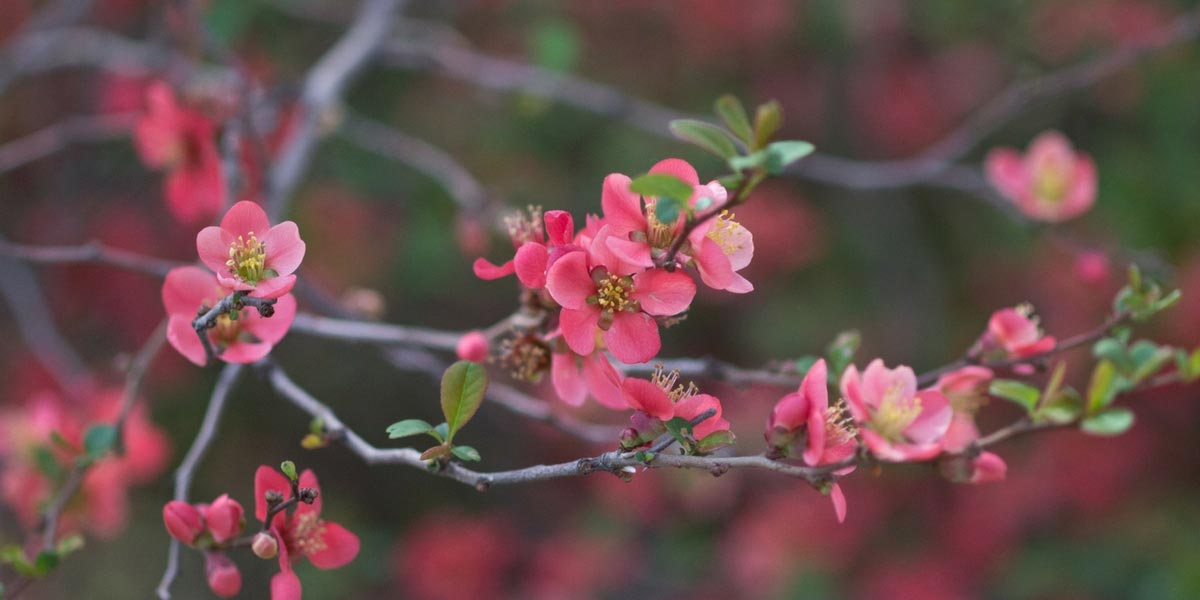
Species and varieties
There are three known species of Japanese quince, but hundreds of hybrids and cultivars exist. The true Japanese quince is Chaenomeles japonica, which is thorny and bears red or orange flowers. Along with the typical species C. speciosa, it has given rise to numerous hybrids under the name Chaenomeles x superba. These have a more rounded habit and intermediate heights of 1 to 1.5 metres. The third species is C. cathayensis, which is taller (5 m) and also bears the largest fruits.
Their size ranges from dwarf shrubs to large shrubs, and their flower colours vary from bright red to pure white, including delicate pinks and salmon tones, as well as the presence or absence of thorns.
For bonsai cultivation, opt for nearly creeping and well-twisted cultivars that are not too tall, making them easy to control, such as ‘Falconet Charlet’, with its lovely double pink flowers—they develop beautifully branched stems with little effort. Discover our collection of Japanese quinces, including some exclusive varieties!
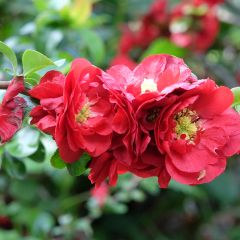
Chaenomeles speciosa Scarlet Storm - Flowering Quince
- Flowering time April, May
- Height at maturity 1 m
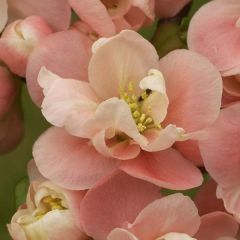
Chaenomeles speciosa Falconnet Charlet - Flowering Quince
- Flowering time April, May
- Height at maturity 2 m
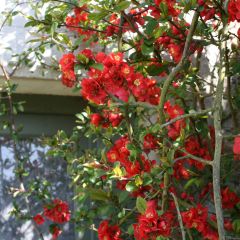
Chaenomeles speciosa Fire dance - Flowering Quince
- Flowering time April, May
- Height at maturity 2 m
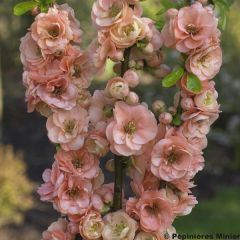
Chaenomeles superba Cameo - Flowering Quince
- Flowering time April, May
- Height at maturity 1,50 m
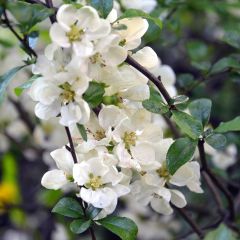
Chaenomeles speciosa Nivalis - Flowering Quince
- Flowering time April, May
- Height at maturity 2,50 m
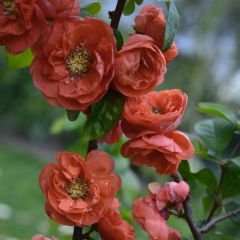
Chaenomeles speciosa Mango Storm - Flowering Quince
- Flowering time April, May
- Height at maturity 1 m
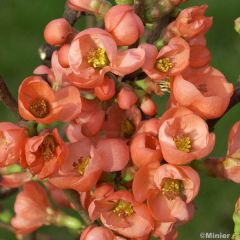
Chaenomeles speciosa Friesdorfer - Flowering Quince
- Flowering time April, May
- Height at maturity 2,50 m
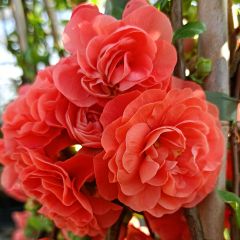
Chaenomeles speciosa Orange Storm - Flowering Quince
- Flowering time April, May
- Height at maturity 1,20 m
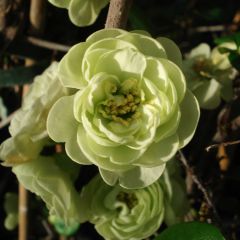
Chaenomeles speciosa Kinshiden - Flowering Quince
- Flowering time April, May
- Height at maturity 2 m
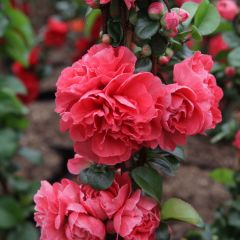
Chaenomeles speciosa Pink Storm - Flowering Quince
- Flowering time April, May
- Height at maturity 1 m
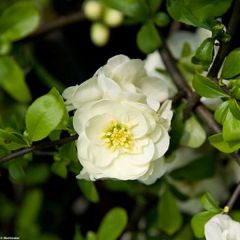
Chaenomeles speciosa Yukigoten - Flowering Quince
- Flowering time April, May
- Height at maturity 1 m

Chaenomeles superba Jet Trail - Flowering Quince
- Flowering time April, May
- Height at maturity 1,50 m
Discover other Chaenomeles - Quince tree
Planting Japanese Quince
Where to plant
Highly hardy, Japanese Quinces can withstand very low temperatures of -20°C, ensuring perfect resilience in all regions.
Undemanding, they thrive in any soil, even poor, acidic or chalky, as long as it’s fresh and well-drained, in sunny positions without scorching sun or partial shade. They only dislike very heavy and waterlogged soils.
Once established, they tolerate everything: sun as well as drought. They fear neither heat, cold nor even air pollution, making them excellent choices for urban gardens or balconies.
These thorny shrubs can be grown equally well as a centrepiece or backdrop in borders or grouped with other shrubs in hedgerows or living hedges. They also form deterrent hedges up to 3m tall. They’ll also feel perfectly at home in an orchard – their small fruits are edible when cooked.
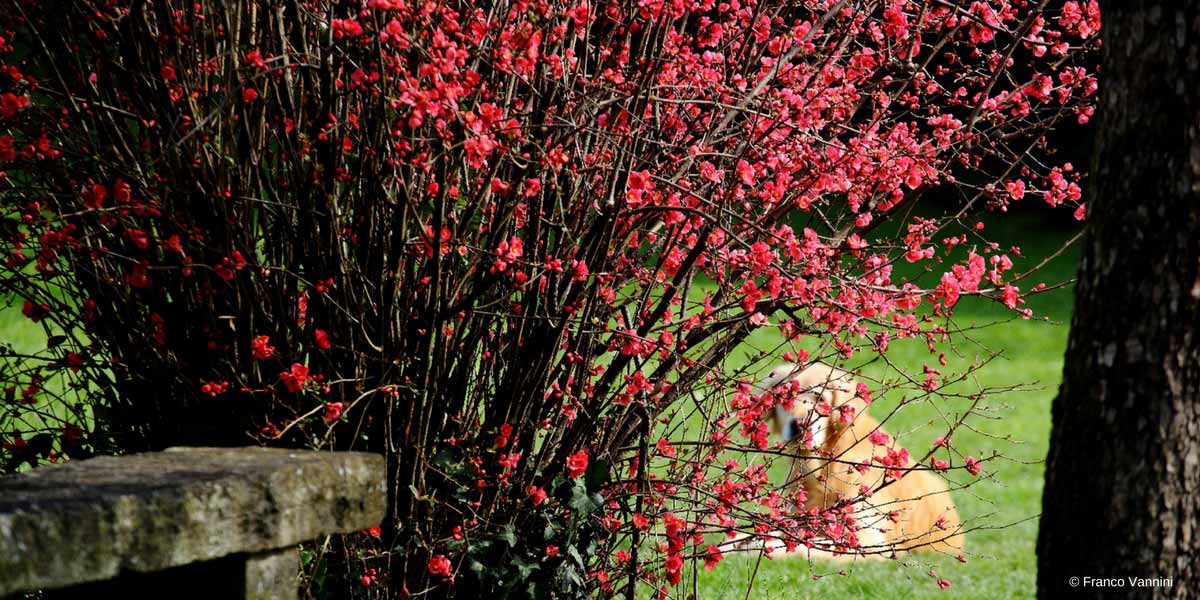
They can be trained against a wall, near the house to tame their natural tendency to become tangled. Avoid planting them in low hedges or passageways though; their thorns penetrate deep into the skin.
Some varieties like the Japanese Quince ‘Sargentii’ also make excellent ground cover on slopes or spectacular bonsai that retain normal-sized flowers on miniature shrubs.
Dwarf varieties (‘Fire Dance’) can be grown in pots and even trained as bonsai.
You can thus enjoy their vibrant spring blooms and fragrant autumn fruits on terraces or near entrances.
When to plant
Container-grown specimens can be planted from October to March, avoiding frost or extreme heat. Autumn planting, from September to November, will encourage better root establishment before winter.
How to plant
In hedges, space Japanese Quinces 80cm to 1m apart depending on variety, reducing this to 50-80cm in borders. They can also be planted in groups of 3 or 5 – in winter they’ll create a magical display.
In open ground
- Dig a hole twice as wide as the root ball
- Add pumice for perfect drainage
- Spread a layer of well-rotted compost at the base
- Plant with the root collar level with the soil surface
- Backfill with excavated soil mixed half-and-half with compost
- Firm gently and water thoroughly after planting, then regularly during the first summer
Hedge planting
Dig a trench 30-50cm deep and 20-30cm wide. Space shrubs about 1m apart. Staking isn’t necessary.
Trained against a wall
Japanese Quince branches can climb to 3m and are easily trained.
- Tie in shoots as they grow
- Encourage lateral growth by removing other branches
In containers
- Choose compact varieties like Chaenomeles ‘Nicoline‘ or ‘Hot Fire’
- Select a sufficiently large container (30-50cm diameter) and deep (minimum 60cm)
- Ensure perfect drainage with clay pebbles or pumice
- Plant in a mix of garden soil and quality compost
- Choose a sunny spot or partial shade in southern regions
- Water regularly (twice weekly in summer)
- Repot every two years into a larger container
Also read How to grow Japanese Quince in pots?
Maintenance, Pruning and Care
Hardy and resistant to both drought and air pollution, Japanese Quinces are vigorous shrubs requiring no specific maintenance. Once well-established after 2-3 years of growth, they need very little watering.
Apply well-rotted compost around the base of the shrub each spring and autumn.
Pruning Japanese Quince
While they don’t require specific pruning, it is advisable to occasionally shorten tangled branches that disrupt the shrub’s shape or overly long ones that may become less floriferous. Over time, these shrubs tend to form a tangled thicket of branches, somewhat unruly. In June, after flowering, every 2-3 years, carry out a rejuvenation prune:
- Shorten branches by one-third, just above a lower branch or bud
- Remove excess branches, dead or broken wood
- Thin out the centre of the shrub by removing crossing branches to allow air and light to circulate
For trained shrubs, cut back the previous year’s growth in May, annually, to 2-3 buds from the main branch.
Bonsai Pruning
Naturally compact, some Chaenomeles make excellent bonsai subjects: their leaves can be miniaturised while the flowers retain their original size! This requires formative pruning in the early years. They tolerate even severe pruning well.
Remove all suckers as soon as they appear and perform short pruning after flowering. This will encourage the development of a gnarled trunk, but be patient—it takes at least 5 years to achieve a trunk 2 cm thick.
Potential diseases and pests
Japanese Quinces are vigorous flowering shrubs that show fairly good resistance to diseases.
However, canker, aphids and scale insects, recognisable by the presence of powdery clusters, can weaken them. Against the latter, in spring, treat the stems with sprays of a mixture of vegetable oil (rapeseed or olive oil), 90° alcohol and black soap which will suffocate them; repeat if necessary every 2-3 weeks. In case of severe infestation, cut off and burn the affected parts.
If the weather is mild and humid in spring, Japanese Quince can become susceptible to scab, a fungus that blackens the foliage and deforms the fruit. Treat preventatively in spring and autumn with Bordeaux mixture. If powdery mildew threatens with its white down: spray nettle manure or horsetail decoction.
Despite their robust nature, Japanese Quinces can fall victim to fire blight, a dreaded disease that particularly attacks the Rosaceae family and can kill the shrub within weeks. Leaves show rust-coloured spots, flower buds and leaves dry out and blacken as if the shrub had been burnt. The only solution: prevent attacks in March-April by spraying Bordeaux mixture or horsetail decoction and prevent contamination (which can spread to neighbouring shrubs) by cutting 20-30 cm below affected parts then burning them.
The shrub can also be affected by quince moniliosis in humid weather. Flowers dry out and fall, branches too, and fruits rot on the tree: treat with Bordeaux mixture in autumn after leaf fall.
→ Also read our advice sheet Diseases and pests of Japanese Quince.
Propagation
Propagating the Japanese Quince can be done by sowing seeds after stratification for species types, or by semi-hardwood cuttings or layering for hybrids. We particularly recommend these last two methods as they are quicker and simpler – young plants propagated this way will flower in their first year, unlike Japanese Quinces grown from seed, which will only flower after 5 years.
Taking Cuttings
- From August to September, take 25 cm cuttings from lateral shoots of semi-hardwood growth
- Remove the lower leaves, keeping only 2-3 leaves at the top
- Plant them in a light mix of river sand and peat
- Cover with plastic film and keep at 16-20°C
- Keep the substrate moist until rooting occurs, which takes 1 to 3 months
- Pot the cuttings individually in October-November in light potting compost. Place under a cold frame or cloche to protect from frost in winter
- Plant your cuttings in the ground the following spring – flowering will occur in the first year
→ Read also: How to take cuttings from Japanese Quince?
Layering
- In autumn, bend a low, flexible branch towards the ground for about 20 cm
- Remove leaves from this section
- Dig a hole 7-10 cm deep to form a small trench
- Make a small cut in the branch and bury it, filling with compost (secure it if needed with pegs or stakes)
- Water the layer generously
- The following spring, you can separate the layer from the parent plant if it has enough roots – otherwise, wait until autumn
- Cut the stem where it enters the soil
- Plant directly in its final position
Pair with
From late winter, their bare branches adorned with vibrant small flowers in pink, red, or white will serve as a backdrop to a beautiful diversity of plants. Japanese Quinces thrive in various settings in the garden, at the back of a flower bed, grouped in informal or defensive hedges, or in spring containers on the terrace or balcony, and even trained against a wall.
Essential in spring displays, Japanese Quinces find their place in natural gardens, in light woodland settings, surrounded by spring bulbs whose blooms coincide with their flowers—narcissi, scillas, hyacinths, botanical tulips, and crown imperials.
In a country hedge, they can be paired with other spring-flowering shrubs, such as yellow or white Forsythias (Abeliophyllum distichum), Lilacs, Japanese cornel, Flowering Cherry, ornamental apple trees, Ribes x gordonianum, or Gordon’s Currant.
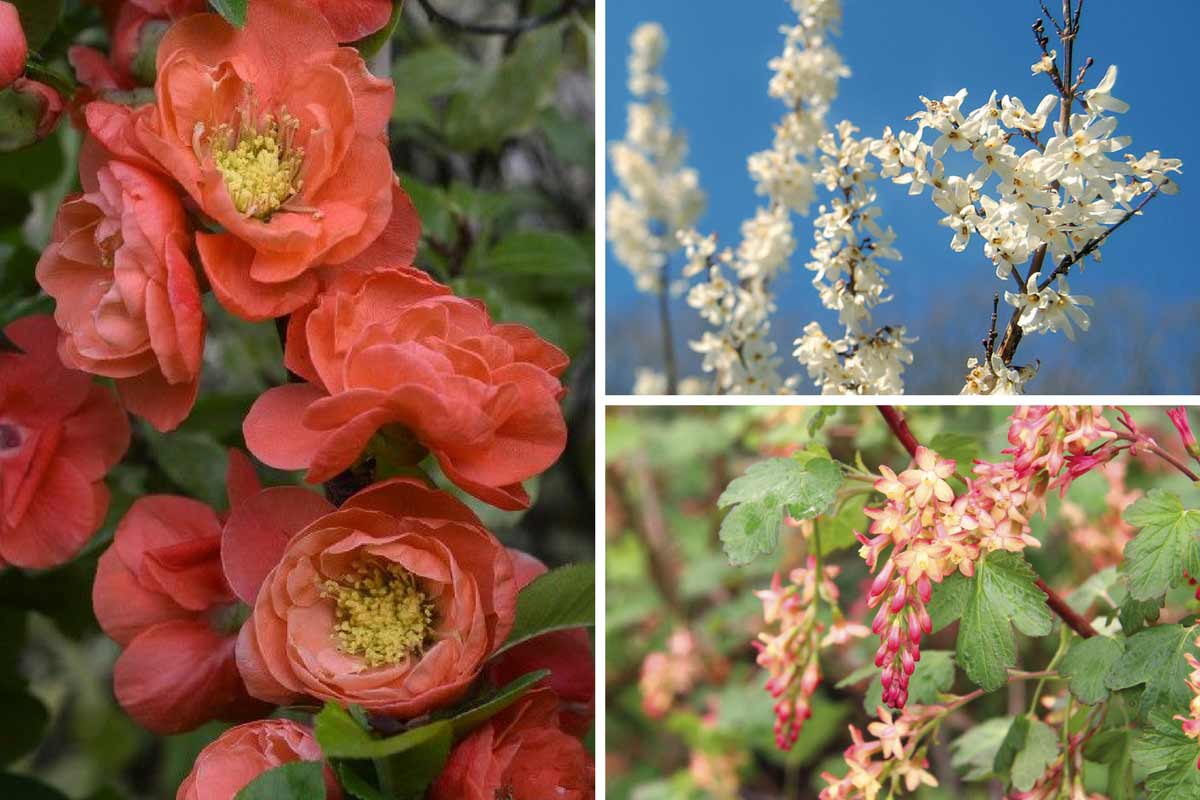
Chaenomeles speciosa Mango Storm – Abeliophyllum distichum – Ribes gordonianum
They are perfect for defensive hedges alongside hawthorns, barberries, blackthorns, or other shrubs with decorative fruits like sea buckthorns, or even edible ones such as strawberry trees.
In a flower bed, pair them with winter hazels, camellias, and low-growing perennials like heucheras, euphorbias, or hardy geraniums to cover the base of the quinces. Buddleias will then take over the flowering display.
On a slope, they blend beautifully with a shrub rose, a creeping rosemary or juniper, or a prostrate ceanothus. Trained against a wall near the house alongside fragrant shrubs like honeysuckle or winter jasmine, they will create enchantment with every passing glance.
→ Discover more lovely ideas for pairing Japanese Quinces in our expert guide!
Useful resources
- Among the earliest flowering shrubs, Japanese Quinces herald the arrival of spring!
- White-flowered, double-flowered or thornless varieties – we have them all!
- Discover 7 early-flowering Japanese Quinces
- Explore our tutorial: How to prune and train a Japanese Quince
- For advice on choosing the right Japanese Quince, visit our guide!
- Our recommendations in The 9 best Japanese Quince varieties for container growing
- Our tips for revitalising an ageing Japanese Quince.
- Japanese Quinces by flower colour: Pink-flowered Japanese Quinces: spring’s awakening in your garden; Orange-flowered Japanese Quinces: bringing life to late winter gardens; Red-flowered Japanese Quinces: a burst of colour in midwinter.
- Subscribe!
- Contents



































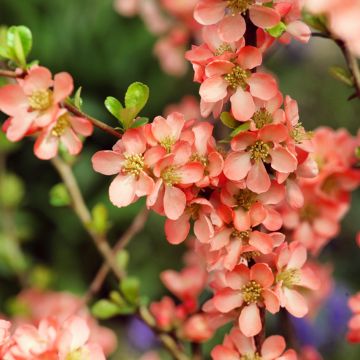
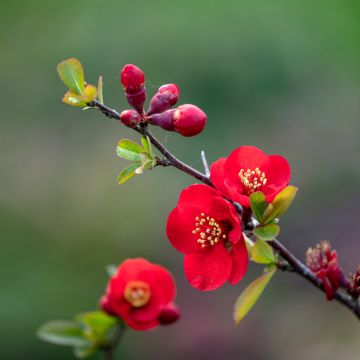





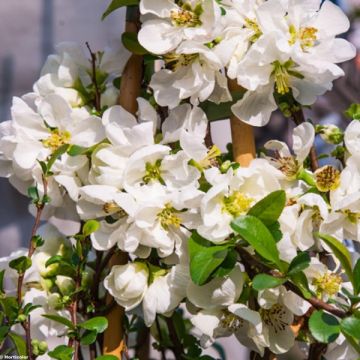
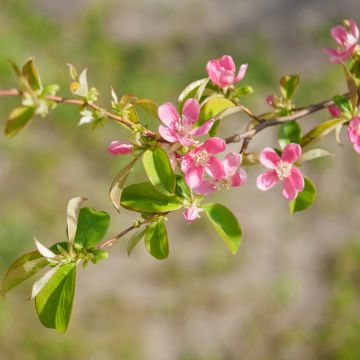
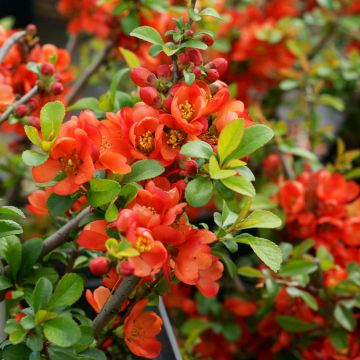
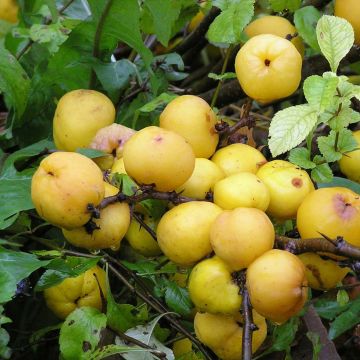

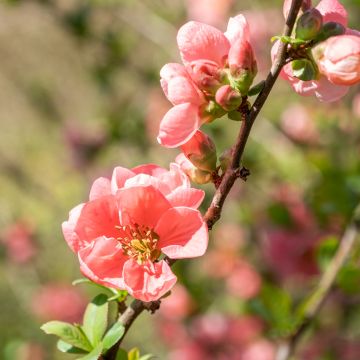

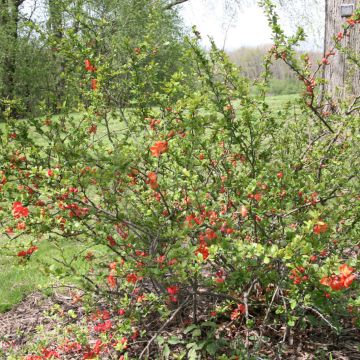
Comments